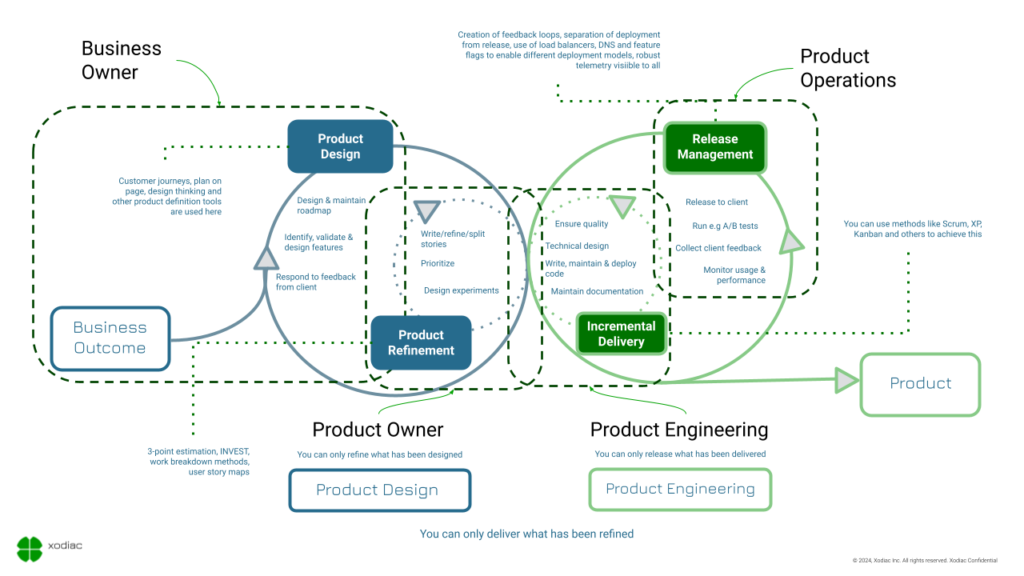The activities, tools, and stakeholders involved in developing products comprise the Product Development Lifecycle (PDLC). Our customers have found the Xodiac PDLC a useful tool to explain how they deliver products and where they currently have gaps, whether in activities, tools, responsibilities, or skills.
The Core Activities of PDLC
Let’s explain the key activities of the Xodiac PDLC, why each activity is necessary, and how they all work together to create a dynamic learning environment.
Effective product development hinges on a well-organized activity sequence that collectively forms the PDLC. These activities are not stages; they are a strategic approach to crafting products that meet user expectations, from which businesses benefit. Their iterative nature enables continuous refinement and improvement of the final product.
The core processes are:
Product Design
It all starts with product design, in which the product’s vision is conceptualized and the core features are outlined. Designers at this stage utilize well-known methods such as design thinking and user research, aiming not only to solve specific user problems but also to uncover latent needs that might still need to have a solution. Customers and stakeholders provide feedback on the result of this activity, so the development process can already take the refinements into account.
Product Refinement
Product refinement translates the design blue-print into feasible plans, identifying valuable product increments and refining the features into stories. This activity goes hand in hand with incremental delivery, continuously improving and expanding the capabilities of the product while focusing on enabling the business outcomes.
Incremental Delivery
With a focus on continuous delivery and continuous testing, each product increment improves upon the last, addressing user feedback along the way. This incremental approach enables early market validation and addresses risk early, as opposed to the late feedback of traditional phased approaches.
Release Management
Release management is the final activity making the product available to all users. Techniques like A/B testing enable controlled exposure to new features to minimize risks and gather crucial data from real-world use. The final objective is to ensure a seamless transition for all customers to new and enhanced features.
The Methods and Tools
During product design, methods such as Customer Journeys, Plan on a Page, Design Thinking, and other product definition tools are pivotal for laying a solid foundation for product development. These methods collectively aim to ensure the product is user-centered, strategically aligned, and clearly defined.
Product refinement benefits from methods and techniques such as 3-Point Estimation, INVEST, User Story Maps and small product experiments. They contribute to making the product development process more concrete, manageable, and aligned with user expectations.
Scrum, XP, and Kanban are good examples of maintaining momentum in product development during incremental delivery. They facilitate a flexible, responsive, and efficient development process that embraces change, focuses on early learning through continuous delivery of value, and maintains high-quality standards.
During release management, you will find techniques like Separation of Deployment from Release, the use of Feature Flags, and Robust Telemetry helpful. They enable user feedback in a controlled and safe way and allow for unintrusive adaptations. Load Balancers, DNS, and more are basic elements of a robust infrastructure supporting flexible deployment strategies, allowing for frictionless rollouts.
In summary, across all activities, these methods, techniques, and tools provide a structured yet flexible framework that guides the product development process from conception to release, ensuring a high-quality product aligned with user needs and business goals.
The People and Roles
People are at the heart of great products. The PDLC benefits from a diverse team with well-understood roles and responsibilities, collectively contributing to the product’s evolution. Here are some key roles within the PDLC:
- Business Owners provide the strategic vision and ensure the product’s alignment with company objectives
- Product Managers are the voice of the customer, prioritize features, and manage the product’s life cycle;
- Designers craft the product’s user experience and interface, ensuring its functionality and ergonomics;
- Developers bring the product to life, building the technical underpinnings that support its features;
- Operations (Ops) provide the infrastructure that enables developers to be productive and play a critical role in its ongoing success and evolution.
Each role brings a distinct perspective, and their collaborative efforts bring the product from the drawing board into the hands of the end user.
Importance of Integration and Feedback Loops
The true power of Xodiac’x PDLC is realized through integrating its activities and establishing effective feedback loops. Integration ensures that every stage supports the next, reducing waste along the way. Feedback loops – involving customers or internal stakeholders – keep the product development lifecycle responsive and relevant. This iterative model allows teams to learn and improve, which is vital in today’s volatile and disruptive market.
Conclusion: Using Xodiac’s PDLC as a Self-Assessment Tool
Xodiac’s PDLC views products as deliverables that grow and evolve, always reaching for new heights and responding effectively to market needs. This PDLC model not only guides the development of individual products but also serves as a self-assessment tool for organizations. By examining your current practices against Xodiac’s PDLC model, you can identify areas of improvement and fill in the gaps. Over time, your PDLC should evolve with the business, helping it maintain a strong product-centric approach essential for sustained success in the competitive market landscape. Supported by the right people, tools, and a culture that values integration and learning, you can improve your products.




